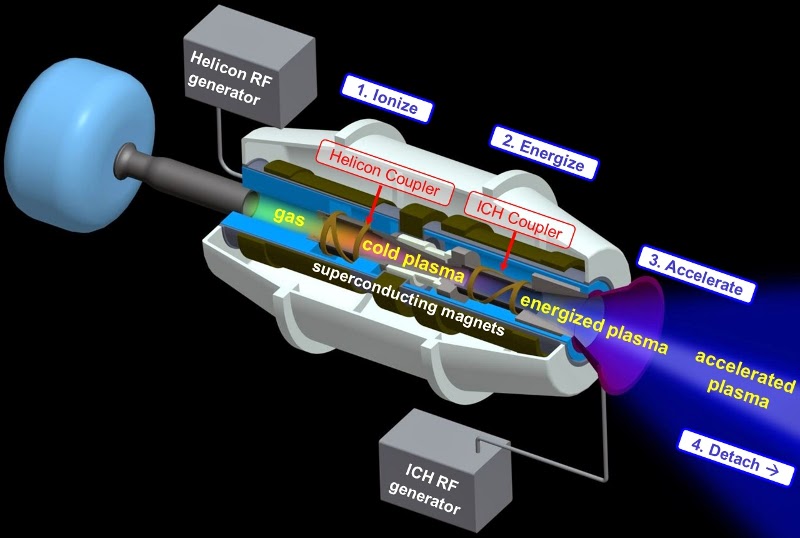Without funding support, the FISO telecon colloquia is an extracurricular activity. The telecon became less a working group tag-up and more, as it is exclusively now, an opportunity for a wide community to be presented with recent work relevant to in-space operations. It is important to understand that the FISO telecon is not a formal NASA activity: there is no NASA logo on our web pages. That being the case, we are able to set our own criteria for presentations. These presentations are co-chaired by a NASA employee, and the telecon uses a NASA toll-free line that is allocated to that co-chair for multiple uses. But other than that, the telecon has no formal connection with the agency. The website where the presentation materials reside is at the University of Texas with the second co-chair.
The Variable Specific Impulse Magnetoplasma Rocket (VASIMR®) engine is a new type of electric thruster with many unique advantages. In a VASIMR® engine, gas such as argon, xenon, or hydrogen is injected into a tube surrounded by a magnet and a series of two radio wave (RF) couplers The couplers turn cold gas into superheated plasma and the rocket’s magnetic nozzle converts the plasma thermal motion into a directed jet.
Principles of Operation
The primary purpose of the first RF coupler is to convert gas into plasma by ionizing it, or knocking an electron loose from each gas atom. It is known as the helicon section, because its coupler is shaped such that it can ionize gas by launching helical waves. Helicon couplers are a common method of generating plasma. After the helicon section, the gas is now “cold plasma”, even though its temperature is greater than the surface of the Sun (5800 K). The plasma is a mixture of electrons and ions (the atoms they were stripped from). The newly formed electrons and ions carry charge and may then be contained by a magnetic field shielding the rocket core from the plasma. The second coupler is called the Ion Cyclotron Heating (ICH) section. ICH is a technique used in fusion experiments to heat plasma to temperatures on the order of those in the Sun’s core (10 million K). The ICH waves push only on the ions as they orbit around the magnetic field lines resulting in accelerated motion and higher temperature.
Thermal motion of ions around the magnetic field lines is mostly perpendicular to the rocket’s direction of travel and must be converted into directed flow to produce thrust. The rocket uses a magnetic nozzle to convert the ions orbital motion into useful linear momentum resulting in ion speeds on the order of 180,000 km/hr (112,000 mph).
VASIMR® Engine Compared to Other Electric Thrusters
The VASIMR® engine has three important features that distinguish it from other plasma propulsion systems:
The VASIMR® engine has the ability to more widely vary its exhaust parameters (thrust and specific impulse) in order to optimize mission requirements resulting in the lowest trip time with the highest delivered payload for a given fuel load.
The VASIMR® engine uses electromagnetic (RF) waves to create and energize the plasma within its core. In this way, the VASIMR® engine has no physical material electrodes in contact with the hot plasma. The lack of electrodes results in greater reliability, longer life, and enables a much higher power density than competing ion and Hall thruster.
The VASIMR® engine is able to process a large amount of power, meaning that it can then generate a larger amount of thrust. This larger thrust capability promises to make the VASIMR® engine useful for moving large payloads around low Earth orbit, transferring payloads from the Earth to the Moon, and transferring payloads from the Earth to the outer solar system. The VASIMR® technology is also highly scalable, meaning that higher power versions can be easily designed; making human missions powered by electric propulsion a reality.
First Flight Unit
The VF-200TM engine is the first flight unit of the VASIMR® engine. It will be tested on the International Space Station (ISS) where the thrust and performance can be measured without the limitations of ground-based space simulation chambers. The VF-200 will consit of two 100 kW thruster units side-by-side.
The VF-200TM engine is being designed to reach the steady-state operating temperature to prove that it is capable of operating indefinitely for future missions. It will use electrical power from the ISS to charge a large battery pack capable of powering the thrusters for approximately 15 minutes at full power. This project will serve as a “pathfinder” for the ISS National Laboratory by demonstrating a new class of larger, more complex science and technology, payloads.

Brian Wang is a Futurist Thought Leader and a popular Science blogger with 1 million readers per month. His blog Nextbigfuture.com is ranked #1 Science News Blog. It covers many disruptive technology and trends including Space, Robotics, Artificial Intelligence, Medicine, Anti-aging Biotechnology, and Nanotechnology.
Known for identifying cutting edge technologies, he is currently a Co-Founder of a startup and fundraiser for high potential early-stage companies. He is the Head of Research for Allocations for deep technology investments and an Angel Investor at Space Angels.
A frequent speaker at corporations, he has been a TEDx speaker, a Singularity University speaker and guest at numerous interviews for radio and podcasts. He is open to public speaking and advising engagements.
















